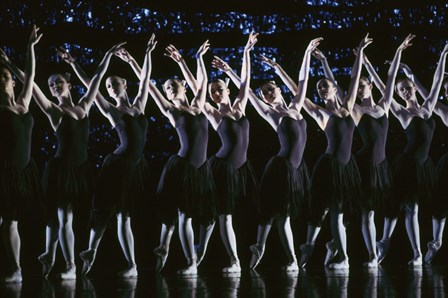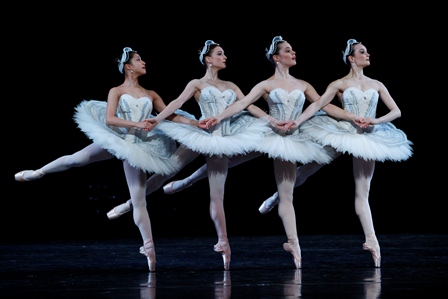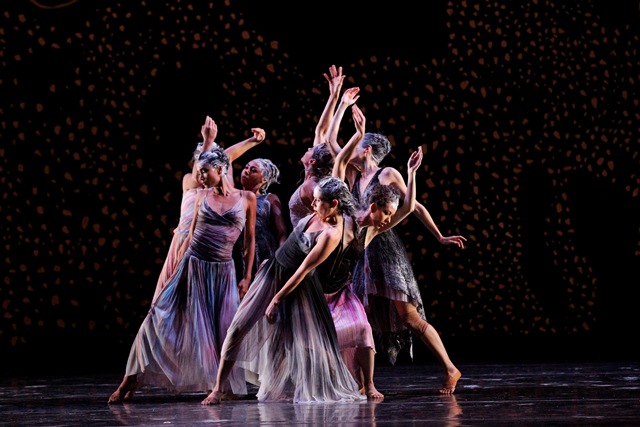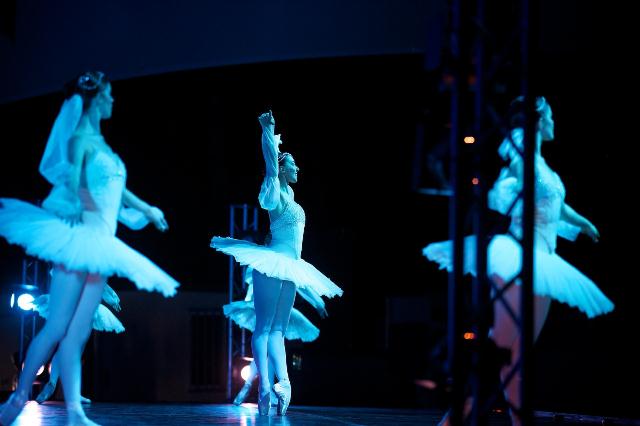22 June 2013 (matinee), State Theatre, Victorian Arts Centre, Melbourne
The first thing to say about this performance of Graeme Murphy’s Swan Lake is that Leanne Stojmenov as Odette was absolutely stunning. It all began with that Act I wedding waltz. Partnered by Andrew Killian as Siegfried, Stojmenov not only danced with delicious fluidity in the upper body, she was also so attuned to the music and was so much the happy young bride. And how often does that beautiful white gown with its long, long train impede parts of the movement? Not this time. The gown was manipulated pretty much perfectly so that, as intended, it was an intrinsic part of the choreography. It was a beautiful and absolutely captivating moment so early into the show and it was followed by some charming encounters between Stojmenov and the guests, especially with the children.
From there Stojmenov delivered some technically sumptuous dancing and swept us through a whole range of emotions until her final disappearance into the depths of the dark waters of the lake. As Odette at the lakeside in Act II her solo, with its remarkable ending—a backwards slide along the floor, was magnificent, as was the pas de deux with Killian, again with its breathtaking ending that moves from Siegfried holding Odette as a limp, bent-over body, which is then stretched out fully but is held parallel to the floor, to a fish dive, and finally to another slide to the floor. And perhaps nothing was more moving in a dramatic sense than Stojmenov’s encounters with Killian in the final moments of Act III. They were danced with all the abandon of a woman in the full knowledge that these moments were to be her last with the man she loves. A series of very fast, perfectly executed turns down the diagonal towards Siegfried, arms flailing up and down, summed it all up.

The second thing to say is that Murphy’s choreography in this work is nothing short of remarkable. Perhaps it is seeing this Swan Lake so soon after Stephen Baynes’ more traditional version that highlights what an expressive choreographer Murphy is. Not many choreographers are able to use the classical medium as an expressive, narrative tool, to move the story along through movement. Murphy does. Take, for example, Siegfried’s solo in Act I as he is torn between his new bride and his old love. He bends into himself, opens his palms wide and places them on his face, and at times moves with little jerky or contorted steps. It all speaks of indecision, inner turmoil, unspoken guilt even. Or take Odette’s meeting with Siegfried in the asylum. Here Murphy gives us all the twitching movements we might associate with Odette’s state of mind and yet there is something about her arm movements that recall those of a more traditional Odette, which not only links us with other stagings of Swan Lake, but also presages Odette’s lakeside dream, which is soon to come.
There are some magnificent images that surface throughout the work. In Act III, as the guests leave the party following the little tantrum by the Baroness, unevenly played on this occasion by Amy Harris, we see Siegfried and his friends against a backcloth that is a representation of M. C. Escher’s linocut, Rippled Surface. They are frantically looking for Odette who has left the party and a very new vision of Siegfried, Benno and friends on their swan hunt (seen in very old productions!) comes straight to mind. And shortly afterwards, when Siegfried arrives suddenly at the lakeside, alone this time, the beautiful choreographic patterns being made by those black swans are just as suddenly scattered into a flurry of different poses and different arm movements. We are left with a fleeting image of a flight of birds disturbed from their ordered existence as if a shot had been fired into their formation.
And I can’t forget Harry Haythorne in Act I as the Marquis (the photographer). While he commands centre stage at times, he also spends a lot of time up in the back OP corner with his camera and his little hanky, a wave of which indicates that a shot has been completed. Taking my eye off the central action for a moment I noticed him arranging a group of children in a special pose, and also photographing a kite that one child was flying. Never one to stand still and just watch the action!
And the third thing to say is that all the drama that was missing from the recent Baynes production was there for all to see in this Murphy production. Murphy’s knack of moving seamlessly from one situation to another and back was evident in Act II as we saw the lakeside dream begin with Siegfried and the Baroness meet outside the asylum window, and saw the dream end with a return to that same meeting. But more than anything the drama was gripping as Odette teetered from one emotion to another.
I do have a couple of gripes. It is annoying that so few of the cast were mentioned by name on the cast sheet. I didn’t have the best seat in the house. It was a way back and a little too much on the side so it was quite hard to identify who was dancing in smaller roles. Who danced the two leading Hungarians in Act I, for example? I thought they did a splendid job, especially the female dancer. [It was Dana Stephensen—see comment from Anna below]. And who danced the little swans and the two leading swans? It is extremely frustrating to have some of the minor characters in Act I named, characters who really have very little to do and certainly no dancing to speak of, when dancers who have relatively substantial dancing roles are not named. And I will never understand why the magic of those last moments has to be spoilt as the black cloth disappears from that circular piece of wood that is the lake leaving us to see a bit of cut chipboard. Come on!
Gripes aside, I was immensely moved by this performance. It was one of those rare performances, I think, where so much pours out, so much underlying logic becomes apparent, so much of the detail of the choreography is made clear, and so much is impossible to record! A huge bouquet to Stojmenov for carrying the dramatic line so well and dancing so sublimely. Performances like this are why I keep going back for more.
Michelle Potter, 23 June 2013
Featured image: Artists of the Australian Ballet in Graeme Murphy’s Swan Lake, ca. 2003

IMAGES: I have no images of this current production as yet and in any case, with Stojmenov giving the performance she did I really am not inclined to post an image of another Odette. The featured image is one supplied by the Australian Ballet some years ago, probably around 2002 or 2003. No photographer’s name is mentioned but I would be more than happy to correct that if someone can supply the name. Looking closely you might notice some dancers who are now principals!
UPDATE (later, 23 June 2013): The second image on this post is indeed of Stojmenov in Murphy’s Swan Lake kindly supplied by the Australian Ballet and by one of my favourite and most generous photographers, Jeff Busby.
A review of the 2015 staging is a this link.


